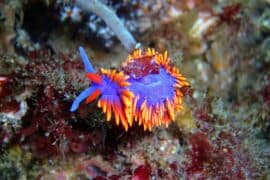Emperor tamarin
(Saguinus imperator)

Description
The emperor tamarin (Saguinus imperator) is a species of tamarin allegedly named for its resemblance to the German emperor Wilhelm II. It lives in the west Brazilian states of Acre and Amazonas and the southwest Amazon Basin, in east Peru, north Bolivia. Emperor tamarins consume a wide range of specimens in their daily dietary routine. They eat fruits and flowers, many of which are readily available due to their flourishing vegetational habitats. They also eat the exudes of plants such as gums and saps, easily gouged from the trees they are living in. Many also choose to consume animal prey, such as insects and frogs, depending upon what type of forest they are located in. Emperor tamarins have been reported to engage in mixed species associations with Weddell's saddle-back tamarins (S. fuscicollis weddelli), spending up to 20% of their day foraging in these mixed species troops. Emperor tamarin society is based on a dominance hierarchy led by a dominant female and her mate. It is the dominant emperor tamarins who form these foraging troops, forming these mixed species groups is beneficial to the emperor tamarins and their ability to find quality food resources. Some speculated at one point that females of the species were the primary scavengers of food, specifically fruit and flowers, because of their enhanced abilities over the males in the form of stronger visual cues. Upon research, it was found that males and females possess the same abilities to locate food patches. Though it does not discriminate between the two species, females do tend to be the more dominant hunters, which led to the speculation. Weddell's saddle-back tamarins are better and faster at locating food resources. S.fuscicollis are a smaller bodied species of tamarins and are able to move fast through the canopy, saddle-back tamarins often arrive to the food resources before the emperor tamarins. The emperor tamarins follow the saddle-back tamarins to food patches using their larger size to intimidate the feeding Weddell's saddle-back tamarins into leaving the feeding tree. This foraging strategy is beneficial to both species, the mixed species troops provide more vigilance for predator protection. Observations of tamarins foraging in mixed species troops using feeding platforms and monitoring fruiting trees show that these troops spend less time foraging in smaller patches of fruiting trees with limited amounts of fruiting resources
Taxonomic tree:







